
Although nicknamed “The Sunshine State,” Florida is far more diverse than you might expect. There is a vast array of habitats – such as rivers and streams, swamps, sawgrass marshes, forests, prairies, and coral reefs. Living in these habitats are thousands of different species of animals – from tiny insects to the impressive Florida black bear. However, alongside these animals are snakes. Florida is home to more than 50 native species of snakes which range from large to small with many different colors and patterns. One of the brightest colors that you will see on a snake is yellow, so join us as we discover some of the yellow snakes in Florida!
1. Eastern Garter Snake

Eastern garter snakes have yellow or whitish-yellow stripes down their bodies.
©Erik Agar/Shutterstock.com
One of the most common yellow snakes in Florida is the eastern garter snake. Eastern garter snakes are typically 18 to 26 inches long and are brown or black with distinct yellow or whitish-yellow stripes. They are extremely versatile and live in a variety of different environments, although abandoned farmland and grassy fields are preferred. Other habitats include lakes, rivers, streams, swamps, and urban environments – even gardens. Eastern garter snakes are ovoviviparous and give birth to live young which are only around 5 inches long at birth. Although eastern garter snakes eat anything they can catch, their main diet is frogs, slugs, and worms.
2. Eastern Rat Snake
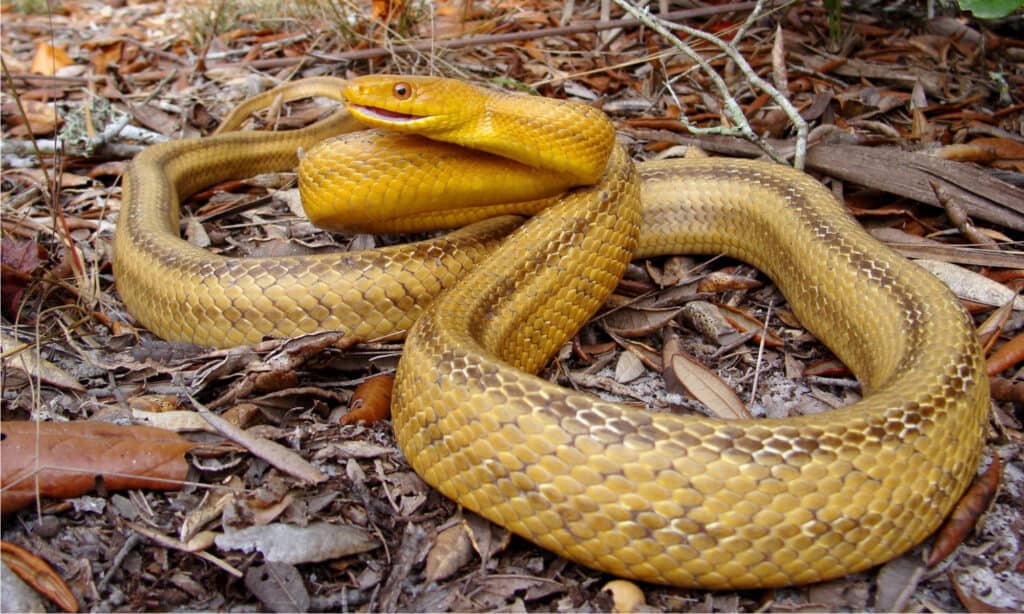
Eastern rat snakes are typically yellow or yellowish-orange.
©Matt Jeppson/Shutterstock.com
Eastern rat snakes are commonly known as yellow rat snakes in Florida where they are found east of the Apalachicola River and as far south as Key Largo. They are 36 to 72 inches long and have thick bodies. Although their color varies across other states, in Florida, they are typically yellow or yellowish-orange with four darker stripes down their bodies. Eastern rat snakes usually live in hardwood forests, thickets, farmland, swamps, and even urban areas. They are nocturnal during the summer but diurnal (active during the day) during the spring and fall. During the winter, they hibernate in burrows underground or in deep crevices. Their main diet consists of birds, frogs, rodents, and lizards. However, they also eat chickens – which is why their other common name is the chicken snake.
3. Ring-Necked Snake
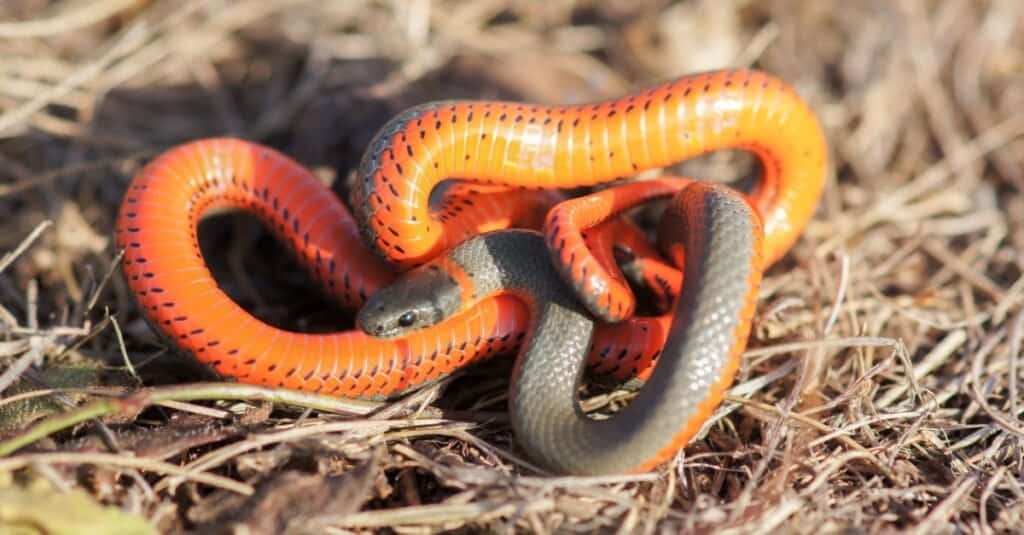
Small and colorful, the ring-necked snake can have a red, orange, or yellow belly.
©yhelfman/Shutterstock.com
One of the smallest snakes on the list is the ring-necked snake which is only 8 to 14 inches long. Ring-necked snakes are black dorsally but have bright red, yellow, or orange bellies and a ring of color around their neck. Many of them even begin with red at one end of their belly that changes to orange and eventually yellow at the tail. Ring-necked snakes are nocturnal, secretive snakes that are rarely encountered during the daytime. They prefer habitats with plenty of cover for them to hide under – such as woodlands and rocky hillsides. Female ring-necked snakes lay between three and ten eggs in loose soil underneath a rock or log. Their eggs have an elongated shape and are white with yellow ends.
4. Striped Crayfish Snake
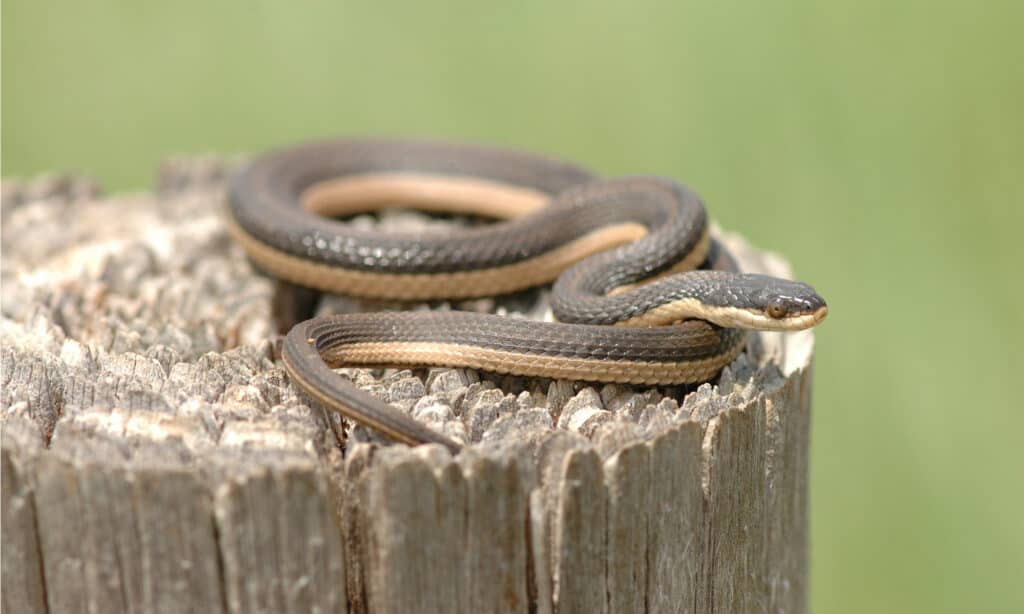
The crayfish snake is commonly seen around ponds and other slow-moving bodies of water.
©Rusty Dodson/Shutterstock.com
Another yellow snake in Florida is the striped crayfish snake which is also known as the striped swamp snake. Striped crayfish snakes are semiaquatic and endemic to Florida where they live in swamps and open wetlands as well as in roadside ditches. They are 13 to 20 inches long and have heavy bodies. Striped crayfish snakes are brown with yellowish-brown bellies. They also usually have three dark stripes down their back and sides. As their name suggests, striped crayfish snakes favor a diet of crayfish. They have small, sharp teeth which they use to grab the tough shell of the crayfish before swallowing their tail first. Juveniles feed on shrimp and dragonfly larvae.
5. Eastern Coral Snake
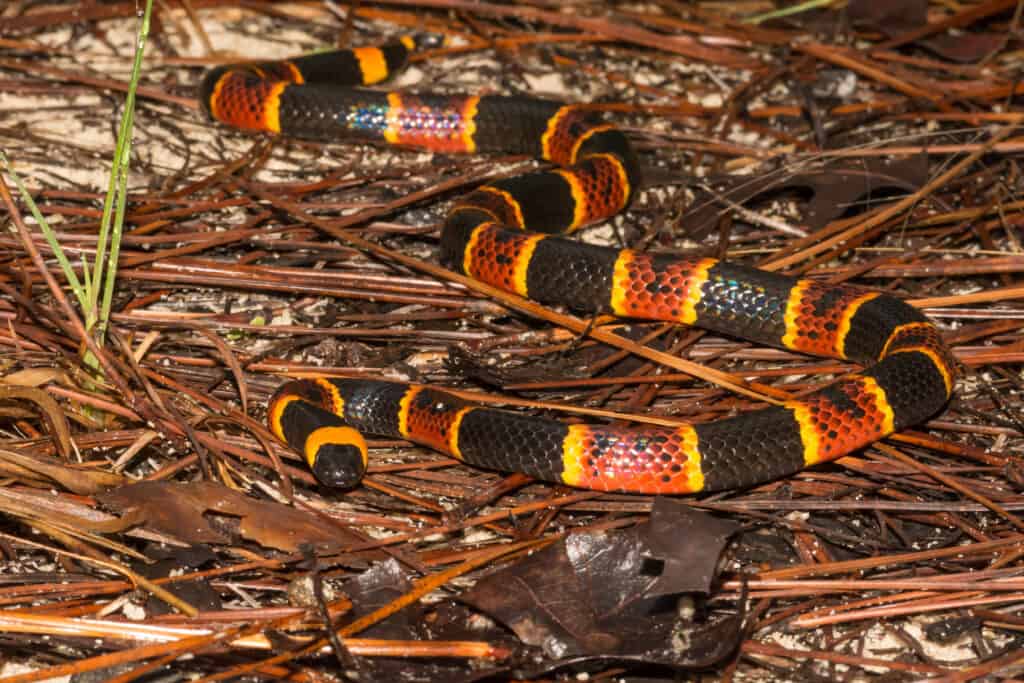
Eastern coral snakes are brightly colored and highly venomous.
©Jay Ondreicka/Shutterstock.com
Although not completely yellow, eastern coral snakes have bright yellow coloration, along with black and red. Eastern coral snakes are highly venomous and their yellow color always separates the red and black which signals this through the saying – “red on yellow kills a fellow, red on black a friend of Jack”. Eastern coral snakes are 20 to 30 inches long and live both in forests and in open areas which lack much vegetation. They mainly eat frogs, lizards, and snakes (including other coral snakes) which they kill using their venom. When threatened, they flatten the rear part of their bodies and wave their tails in the air as a distraction.
6. Scarlet Kingsnake

The non-venomous scarlet kingsnake has an incredibly similar appearance to the venomous coral snake.
©Radiant Reptilia/Shutterstock.com
Although they are incredibly similar in appearance to eastern coral snakes, scarlet kingsnakes are not venomous. They are also typically smaller – being only 16 to 20 inches long. Scarlet kingsnakes have a tricolor pattern of black, red, and yellow. However, black always separates red and yellow colors, which can be used to distinguish scarlet kingsnakes from coral snakes. Scarlet kingsnakes usually live in pine flatwoods, fields, and prairies. However, they are extremely shy and secretive and typically hide underneath logs and rocks. Scarlet kingsnakes are constrictors and kill by wrapping themselves around their prey until they stop breathing. Their diet consists mainly of lizards and small snakes.
7. Rainbow Snake
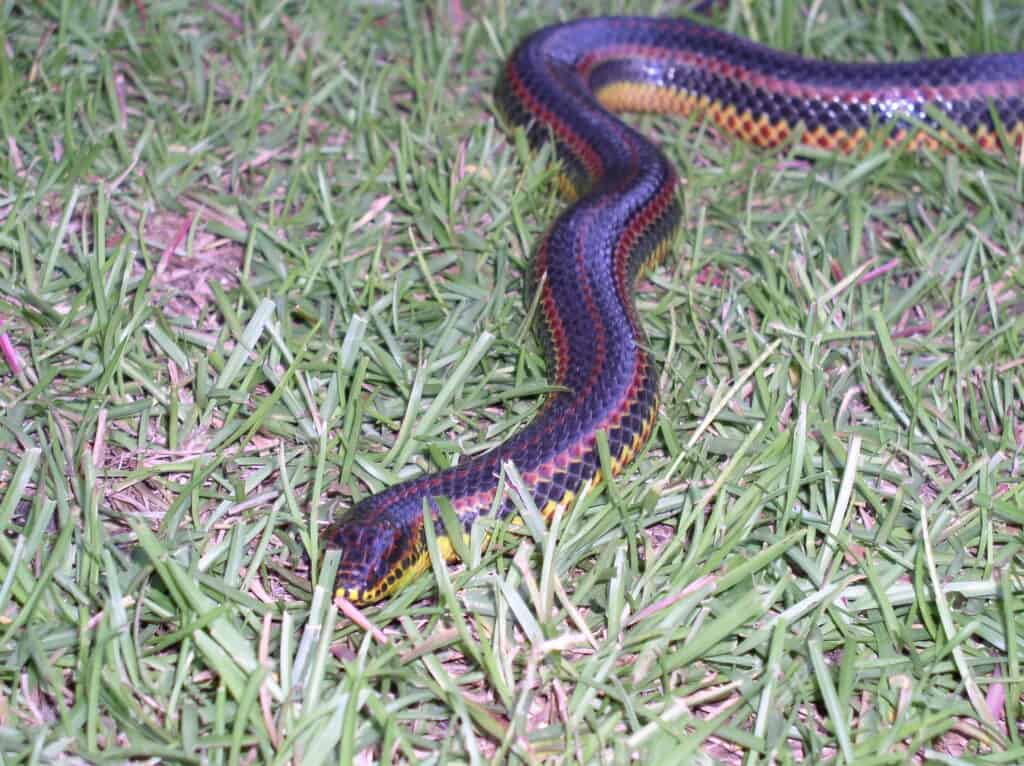
Rainbow snakes are some of the most unusual and stunning snakes around.
©Alan Garrett / Creative Commons – License
One of the most stunning snakes that can be encountered in Florida is without a doubt the rainbow snake. Rainbow snakes are 36 to 48 inches long and most are a glossy black color but have three red stripes running down their back and sides. They also have yellow coloration on the lower sides of their bodies and a yellow throat and chin. Rainbow snakes are highly aquatic and spend the majority of their time in the water in lakes, swamps, and tidal mudflats where they hide underneath aquatic vegetation. Rainbow snakes also burrow into sand and mud and lay their eggs in sandy soil. They feed mainly on eels, but also eat salamanders and frogs.
8. Eastern Ribbon Snake

Eastern ribbon snakes are often confused for garter snakes.
©Steve Bower/Shutterstock.com
Another unusual yellow snake in Florida is the eastern ribbon snake. Not to be confused with the similar eastern garter snakes, eastern ribbon snakes are a subspecies of ribbon snakes. They get their name from their slender bodies which are thinner than garter snakes. Eastern ribbon snakes are typically between 7 and 34 inches long. They are black or brown but have thin yellowish stripes running down the center of their back and either side of their bodies. The scales around their mouth are usually bright yellow, as are the markings at the front of their eyes. Eastern ribbon snakes live in wetland habitats near ponds and streams and are found both in and out of the water. Eastern ribbon snakes are not venomous or constrictors, and prey is swallowed alive. Their main diet is small fish, frogs, tadpoles, and salamanders.
What Is the Florida Super-Snake?
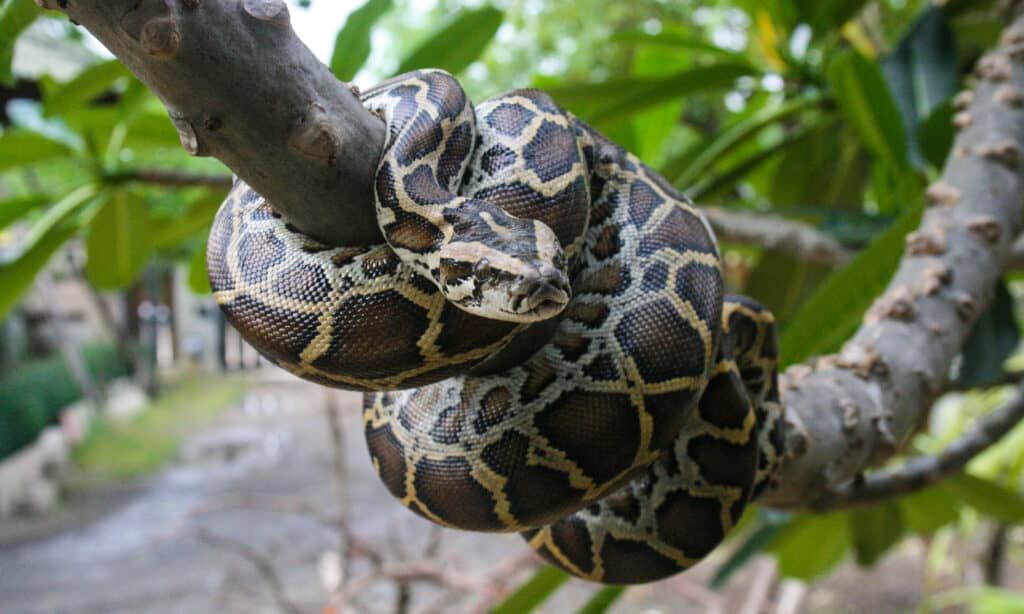
Some
Burmese pythons
slithering about in the Everglades seem to have been cross-bred with Indian rock pythons, which could evolve into a super-snake the world has not yet seen.
©iStock.com/Lunatic_67
While we’ve concentrated on snakes in sunny Florida which have the sunny color of yellow on their scales, there’s one particular snake that’s creating quite a buzz in the state for other reasons. Folks have been hearing about a “super-snake,” and are quite concerned about it. What is this mystery snake, and does it pose a threat?
The snake in question is a hybrid super-predator that’s made an appearance in the Florida Everglades–an area already crawling with invasive species from toxic frogs to lizards to snakes. A study was conducted in which US Geological Survey (USGS) scientists studied 400 snakes captured in that region over 10 years time starting in 2001. They were expecting to find pure Burmese pythons among them. However, in 13 or more snakes, they had traces of Indian rock pythons in their gene pool. Interestingly, the latter snake is smaller and faster than the Burmese python and is usually found on dry ground.
While experts think the two species may have been cross-bred before finding their way to the Everglades, the result could be a super-snake that takes the strongest characteristics of each breed to thrive and multiply even better than the pure-lined snakes. With pythons already destroying other wildlife and vegetation in the swampland, this just could make efforts to rid it of invasive snakes that much harder.
Summary Of 8 Yellow Snakes In Florida
| Rank | Yellow Snake |
|---|---|
| 1 | Eastern Garter Snake |
| 2 | Eastern Rat Snake |
| 3 | Ring-Necked Snake |
| 4 | Striped Crayfish Snake |
| 5 | Eastern Coral Snake |
| 6 | Scarlet Kingsnake |
| 7 | Rainbow Snake |
| 8 | Eastern Ribbon Snake |
The photo featured at the top of this post is © Matt Jeppson/Shutterstock.com
Discover the "Monster" Snake 5X Bigger than an Anaconda
Every day A-Z Animals sends out some of the most incredible facts in the world from our free newsletter. Want to discover the 10 most beautiful snakes in the world, a "snake island" where you're never more than 3 feet from danger, or a "monster" snake 5X larger than an anaconda? Then sign up right now and you'll start receiving our daily newsletter absolutely free.
Thank you for reading! Have some feedback for us? Contact the AZ Animals editorial team.






